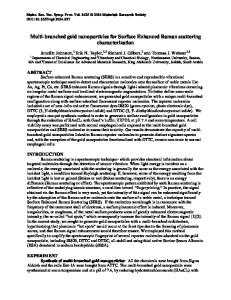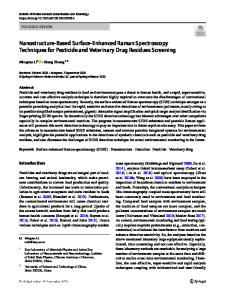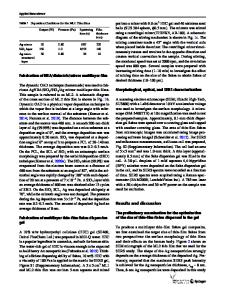Si nanowire-gold nanoparticles heterostructures for surface enhanced Raman spectroscopy
- PDF / 361,173 Bytes
- 6 Pages / 432 x 648 pts Page_size
- 64 Downloads / 450 Views
Si nanowire-gold nanoparticles heterostructures for surface enhanced Raman spectroscopy Yuan Li1, John C. Dykes3, and Nitin Chopra1,2 Metallurgical and Materials Engineering Department, Center for Materials for Information Technology (MINT), The University of Alabama, Tuscaloosa, AL 35487, U.S.A. 2 Department of Biological Sciences, The University of Alabama, Tuscaloosa, AL 35487, U.S.A. 3 REU, Department of Mathematics, The University of Alabama, Tuscaloosa, AL 35487, U.S.A *Corresponding Author E mail: [email protected], Tel: 205-348-4153, Fax: 205-348-2164 1
ABSTRACT Here, we present a method for the fabrication of silicon (Si) nanowires and Si nanowiregold nanoparticles (AuNPs) heterostructures for surface-enhanced Raman scattering (SERS) effect. Branched Si nanowires were grown in atmospheric pressure chemical vapor deposition (CVD) process. Further decoration of these nanowires was achieved by a galvanic deposition of gold followed by annealing procedure. This resulted in Si nanowires-AuNPs heterostructures with controlled size and inter-particle spacing. Furthermore, the fabricated heterostructures were studied for Raman signal enhancement of the low concentration (~10-6 M) dye (Rhodamine 6G, R6G). It was observed that heterostructuring of SiNWs with AuNPs led to improvement of R6G signals as compared to AuNPs dispersed on flat Si substrate. INTRODUCTION Silicon nanowires (Si nanowires) grown from gold catalyst by vapor-liquid-solid (VLS) mechanism have been widely studied for field-effect transistors, solar cells, and sensors due to their excellent electronic and surface properties [1,2]. Specifically, application of Si nanowires in chemical sensors would be due to their bio-compatibility, high surface-to-volume ratio, fast response, good reversibility, and native oxide-coating or H-terminated surface [3-5]. Towards this end, surface-enhanced Raman Spectroscopy (SERS) based on Si nanowires could be a powerful analytical technique [6-11]. However, this would be best achieved by integrating or heterostructuring Si nanowires with plasmonic nanostructures such as gold nanoparticles (AuNPs). Such an approach can result in significant Raman signal enhancement with high spatial resolution. Recent studies have shown the feasibility of using Si nanowire as the backbone to support metal nanostructures [12]. This has also led to tip enhanced Raman scattering (TERS) [13-15]. Apart from high surface area for loading molecules, appropriate geometry and spatial arrangement, surface roughness in such heterostructures is necessary to achieve the Raman signal enhancement. Compared with silver-based substrate, AuNPs are considered to be of increasing importance due to their chemical stability and excellent biocompatibility. Here, we report an approach to utilize dewetted gold films to result in uniform dispersion of AuNPs, which are further used as catalysts to grow Si nanowires through the Chemical Vapor Deposition (CVD) method. These nanowires were further uniformly coated with AuNPs by a galvanic deposition-annealing proc
Data Loading...











